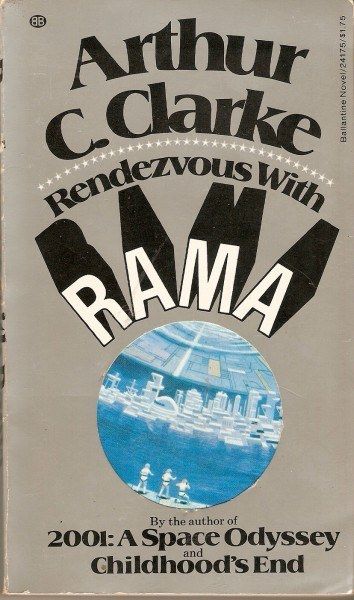Take Me to Some Twilight Land
Rendezvous with Rama
By Arthur C. Clarke

19 Apr, 2020
Arthur C. Clarke’s 1973’s Rendezvous with Rama is a first-contact science fiction novel.
In the early 22nd century the Spaceguard warning system detects an asteroid-sized body passing through the Solar System. Although the object will not come near Earth and thus falls outside Spaceguard’s main mission, the body has a number of unusual characteristics that warrant investigation: the object is of extrasolar origin and will exit the Solar System once it passes the Sun; it appears to have smooth surface and a rotation period measured in minutes. It cannot be a comet. A closer look by a space probe reveals that it is an alien space craft. It is dubbed “Rama.”
Only one crewed spacecraft is in the right orbit with enough fuel reserves to match course with Rama: Commander Norton’s Endeavour.
Rama is a vast, hollow cylinder, twenty kilometres in diameter, and fifty kilometres long. Despite its great age, the airlocks are still perfectly functional. The explorers soon gain access to its unlit interior. Inside, Rama appears utterly dead. No surprise since Rama’s path last passed by a star a hundred thousand years ago, and there is reason to think that the previous system was not its point of origin.
As the vast artifact approaches the Sun, it begins to change. Long-frozen seas melt; long-dormant lights begin to glow; oxygen content of the air rises. The vessel’s interior sea blooms with alien life (apparently non-sentient life).
Untrained for archaeological research, equipped only for standard interplanetary missions, the crew of the Endeavour does their best to unravel Rama’s secrets in the short time available. What they are learning only scratches the surface … but what they do learn is tantalizing.
~oOo~
By 1973 even British authors had discovered the existence of women. Endeavourhas at least one woman (or “lady officer,” as the text calls Surgeon-Commander Laura Ernst) on board. She is described with all the delicacy one would expect from a guy who once wrote for Astounding.
Yet whenever the well-built Surgeon oscillated into the Commander’s cabin …
The book also features simps, genetically engineered monkeys who do most of the manual labour on the ship. They are hardworking and docile, but have no real function in the plot. Why include them? It could be a suggestion that humans, like Ramans, are progressing towards a tomorrow where all things, living and machine, are designed and created to serve pre-selected roles. It could also be that Clarke, born years before the British Empire dissolved, was simply unable to imagine a future without some unfortunate caste — humans when available and created beings when they are not — to do all the hard physical labour and so free the upper classes for more intellectual pursuits.
The book sold well and the publisher went all out for the paperback version. That edition had a cover window1 and a fold-out illustration of Rama’s interior.


Not only did it sell well, it won awards.
- 1974 Campbell Memorial Best Science Fiction Novel, tying with Robert Merle’s Maleviland beating Ian Watson’s The Embedding and Peter Dickenson’s The Green Gene.
- The 1974 Best Novel Hugo, beating Robert A. Heinlein’s Time Enough for Love, Larry Niven’s Protector, David Gerrold’s The Man Who Folded Himself, and Poul Anderson’s The People of the Wind.
- 1974 Locus Best SF Novel, defeating Heinlein’s Time Enough for Love, Anderson’s The People of the Wind, Protector, and Gerrold’s The Man Who Folded Himself2.
- 1974 Nebula for Best Novel, beating Thomas Pynchon’s Gravity’s Rainbow, Gerrold’s The Man Who Folded Himself, Anderson’s The People of the Wind, and Heinlein’s Time Enough for Love.
There’s not a lot of plot in this novel. The humans, a collection of paper-thin archetypes, discover and explore an enigmatic object, get answers to a fraction of their questions, and then are forced by orbital dynamics to leave with many of their questions unanswered. But the book is surprisingly effective for all that. Readers are prompted to question, given some answers, and left to mull over all the unanswered questions. Providing answers might have been a grave error, so it’s providential that there are no sequels to this work (that I feel compelled to acknowledge).
Rendezvous with Ramais available here (Amazon US), here (Amazon Canada), here (Amazon UK), here (Book Depository), and here (Chapters-Indigo).
1: The paperback was very impressive. Pity cover windows like that are so prone to snagging and ripping….
2: The full list of finalists is available here.
